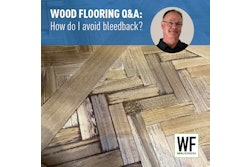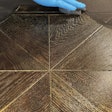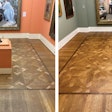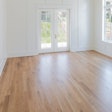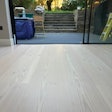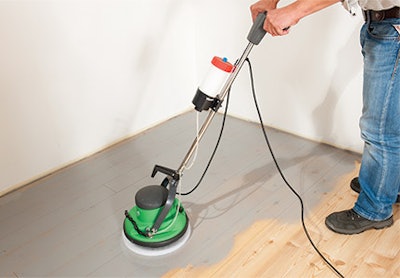


 Top, a particularly even color dispersion is achieved when the finish is buffed in with a buffer. Center, the second coat is a hardwax oil. It protects the pigments in the first coat against abrasion and results in a surface that is water- and dirt-repellent, smudgeproof and extremely resilient. Bottom, with colored oil and wax-based finishes, the natural wood color can be changed and adjusted to meet the customers' wishes.
Top, a particularly even color dispersion is achieved when the finish is buffed in with a buffer. Center, the second coat is a hardwax oil. It protects the pigments in the first coat against abrasion and results in a surface that is water- and dirt-repellent, smudgeproof and extremely resilient. Bottom, with colored oil and wax-based finishes, the natural wood color can be changed and adjusted to meet the customers' wishes.
Whether making old wood flooring shine like new, changing the color of new flooring so it fits into the interior design or adding an individual accent with colored wood flooring, homeowners on the lookout for something special can choose to have their floors coated with a colored oil-and-wax-based wood finish. With this, the natural wood color can be changed and adjusted to meet customers' wishes.
Besides creating a decorative effect, the optimal protection of wood is naturally a high priority. An oil-and-wax-based finish protects the wood from inside and out, forming a microporous surface. In comparison with common finishing systems, the use of plant ingredients results in a more even color as well as a more harmonious appearance. The surface repels water and dirt and is durable and extremely resilient. When dry, it is resistant to saliva and perspiration and thus it is also suitable for children's toys.
Oil-and-wax-based finishes are available in many colors, from trendy grays to warm brown tones or even in a transparent white. Additionally, if the contractor cannot find the right color, the colors can be mixed with each other.
Another advantage is the ease of application with this natural wood finish. First, the floor must be freed of any dust and dirt. Optimal finishing results are achieved with 120 grit as the final sanding step. Before applying the first coat, the finish must be stirred thoroughly so that color pigments, waxes and oils are mixed well with each other.
Then the first coat can be applied to the raw, sanded wood. The color dispersion is particularly even when the finish is buffed into floorboards with a single-disk machine. For old and textured flooring, applications with a flooring brush are possible without any problems—small mistakes in the finish can be touched up within 30 minutes after application. With 1 liter, approximately 258 square feet of wood flooring can be colored with one coat. It is essential to apply only thin coats along the wood grain.
After the first coat, the flooring must be ventilated well while it dries for 24 hours. The second coat should be carried out with a hardwax oil. It protects the pigments in oil and wax-based finish against abrasion and makes the surface repellent to dirt and water, smudgeproof and extremely resilient. With 1 liter of hardwax oil, you can protect approximately 258 square feet of wood flooring. The second coat should dry for approximately 8–10 hours. Then the floor can be walked upon and used as normal. Since hardwax oils dried through oxidization require about two weeks to completely cure, rugs and mats should be laid out only after this period of time.
Another advantage of an oil-and-wax-based surface finish is the simple renovation: Traffic marks and small scratches can be removed through spot repairs—it is not necessary to sand the entire floor. The damaged area is simply marked off, sanded and afterward treated as described above.
For a fast and easy cleaning of the surface, a non-aggressive household cleaner can be used. The surface can, for example, be cleaned quite simply with a spray-mop system. With that, oil-and-wax-based surfaces are just as easy to clean as wood floors with finishes such as urethanes that stay on the surface of the flooring.
This article was paid for by Warendorf, Germany-based Osmo. For more information, visit www.osmousa.com and www.osmo.ca.

















